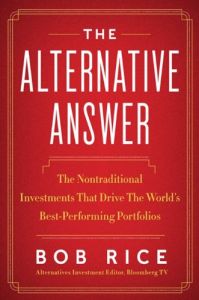Join getAbstract to access the summary!

Join getAbstract to access the summary!
Bob Rice
The Alternative Answer
The Nontraditional Investments That Drive the World’s Best-Performing Portfolios
HarperBusiness, 2013
What's inside?
Alternatives to stocks and bonds strengthen investment portfolios by increasing their tolerance to all types of risk.
Recommendation
Investment expert Bob Rice believes that more investors should add alternative assets to their portfolios of stocks and bonds for greater long-term returns with less total risk. Mutual funds, exchange-traded funds and similar vehicles now offer exposure to long/short stock strategies, oil and gas royalties, private equity, timber and many other types of alternative investments. Such assets may not outperform stocks in the short term, but, because alternatives’ returns are uncorrelated with equity returns, they can resist depreciation when share prices fall. However, Rice cautions in this breezy and informal but instructive text, choosing wisely is critical: Alternatives managers tend to produce a wider variety of good and bad results than those who handle only equities and fixed-income assets. While not advocating any particular investment or investment strategy, getAbstract recommends this overview to individual investors looking for ideas on how to improve their portfolio performance and protect their gains from bear markets, recessions and inflation.
Summary
About the Author
Bob Rice is Bloomberg TV’s alternative-investments editor and the managing partner of Tangent Capital.
















Comment on this summary